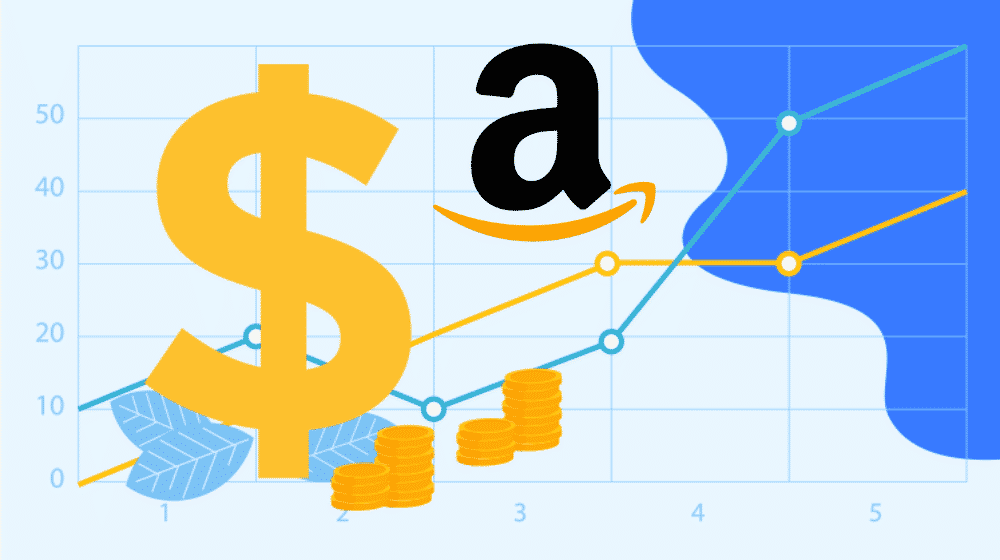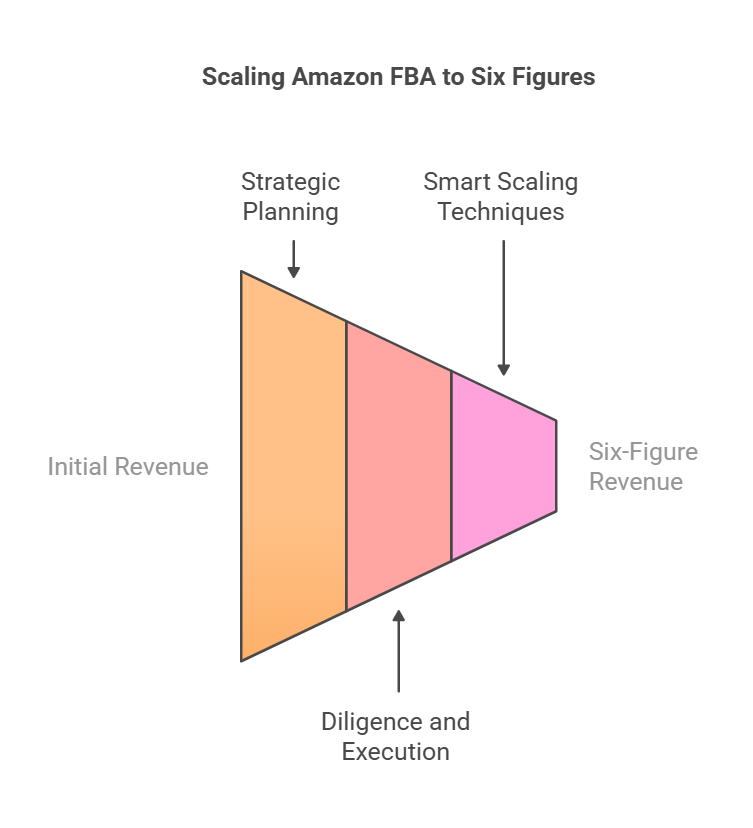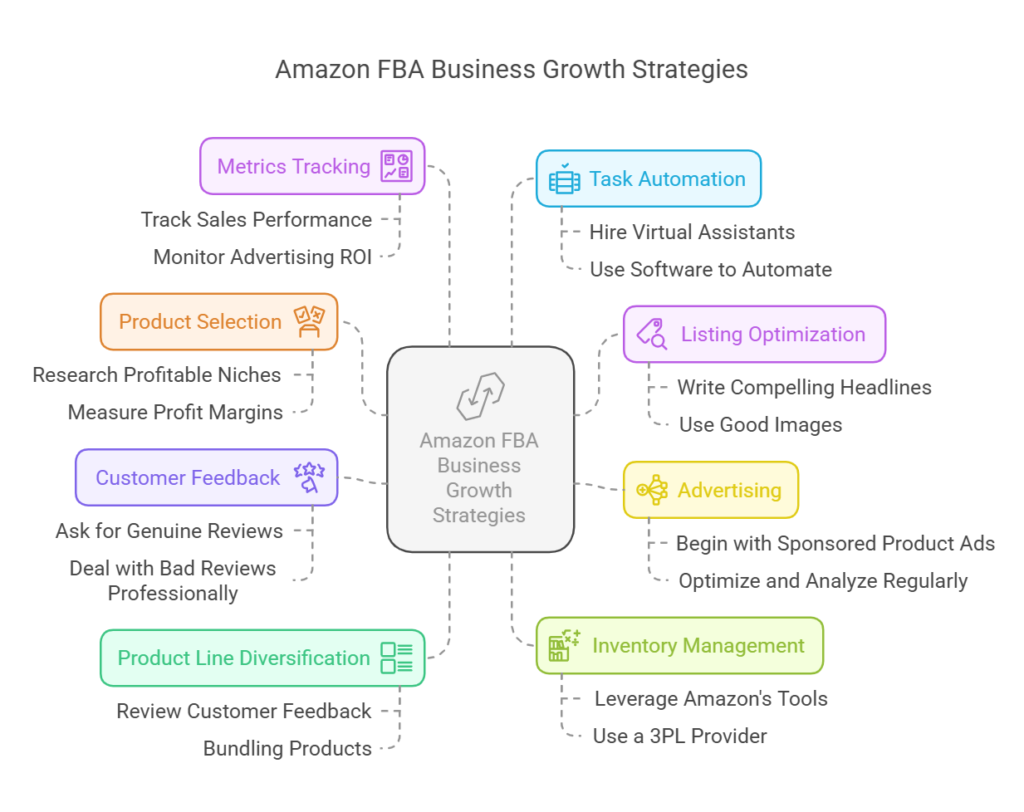Article
How to Scale Your Amazon FBA Business from $1,000 to $100,000+

Share
How to Scale Your Amazon FBA Business from $1,000 to $100,000+
Bootstrapping your Amazon FBA business is a thrilling adventure. The prospect of creating a business with relatively low capital and the possibility of huge revenues entices entrepreneurs from around the globe. Yet, scaling your Amazon FBA business from $1,000 in revenue to $100,000+ takes strategic planning, diligence, and smart scaling techniques.
If you are planning to scale your Amazon FBA business to six figures and beyond, then you are at the right post. In this blog, we will discuss basic business expansion strategies step by step.

Begin with the Right Product Selection
Product selection is the key to your Amazon FBA business. Begin with an amazing, trending product to lay the foundation for future growth.
I hope you were able to find something useful.
Research Profitable Niches: Research product demand, competition, and profitability using tools such as Jungle Scout, Helium 10, or AMZScout. You are looking for products with high demand and low competition.
Target Small and Medium Sized Markets: Although it is tempting to target a “hot” product category, such as electronics or beauty, these categories are oversaturated. Target niches where you can be the one that stands out.
Measure Profit Margins: Find items that offer a minimum 30-40% margin once you factor in product cost, shipping cost, FBA charge of Amazon, and the advertising expenditure.
Pro Tip: Go small in beginning with one product or with a cluster of related products. You will then prioritize quality over quantity and be able to establish a niche space where your brand stands out.
Optimize Amazon Listings for Conversions
No matter how good your product is, if your listing isn’t optimized for conversions, you’ll struggle to grow. Your product listing needs to stand out and convince potential customers that your product is the best choice.
Write Compelling Headlines: Utilize keywords, but make the headline clear and concise. Avoid keyword stuffing but place the key information customers must be aware of (e.g., product type, size, color, primary features).
Good Images: Use good quality, high-resolution images. Display your product from multiple angles and in various settings (e.g., someone using the product or product with a ruler placed next to it for comparison purposes).
Create Persuasive Bullet Points & Descriptions: Highlight benefits rather than features. Describe how your product will assist the customer, solving their issue or improving their life. Be concise and compelling with a clear format.
Utilize Enhanced Brand Content (EBC): If you are registered as a brand, use EBC to add more content to your listing, like personalized images, comparison tables, and other details so that the customers can make educated decisions.
Use Amazon PPC and Sponsored Ads
Scaling your Amazon FBA business is among the best uses of Amazon’s advertising platform (PPC – Pay Per Click). However, like any other marketing tool, it must be properly optimized and controlled.
Begin with Sponsored Product Ads: They are most sought after and easiest method of advertising your products on Amazon. Begin with minimal daily budget, and employ automated targeting to identify the keywords that provide the best conversions.
Optimize and Analyze on Regular Basis: Track the performance of your PPC campaigns. Optimize bids, add negative keywords, and maximize the ads that bring you the highest ROI.
Scale with Sponsored Brand and Sponsored Display Ads: After getting Sponsored Products right, experiment with Sponsored Brands (promoting your brand name and range of products) and Sponsored Display Ads (appealing to off-and-on Amazon buyers).
Pro Tip: Scale slowly, beginning with tiny campaigns. In this way, you won’t bankrupt yourself as you’re getting used to the platform.
Monitor Customer Reviews and Feedback
Customer reviews are a crucial conversion driver as well as a determinant of sustainable business success. In fact, the greater number of reviews you have, the higher ranking your product will enjoy on Amazon’s search results.
Ask for Genuine Reviews: Once you’ve made a sale, Amazon permits you to contact customers. Politely request them to review your product if they’re happy. Automate using FeedbackWhiz, AMZFinder, or Jungle Scout.
Deal with Bad Reviews Professionally: There are always going to be a couple of negative reviews for every company. Respond in a cool, professional tone, with fixes if needed. Bad reviews are an opportunity to get better at products or customer service.
Tip: Have a minimum of 10-20 positive reviews before you expand your ad campaigns because it will increase your success chances in the crowded Amazon environment.
Diversify Your Product Line
After consistently selling one or two products, it’s now time to think about growing your product line. This is probably the best way to grow your business without beginning all over again.
Review Customer Feedback: Look at feedback, questions, and remarks about your present products. Are customers asking for features or product changes? Use this data to create products which meet their needs.
Bundling: Bundling items is also an excellent strategy. For instance, if you are selling an appliance for a kitchen, you can bundle it with complementary products such as a cleaning brush or a cookbook to raise the perceived value to the consumer.
Cross-Sell with Similar Products: Look for complementary products in your product category and diversify. A customer buying one product is likely to buy another, so you raise the sales volume on your overall books.
Optimize Your Inventory and Supply Chain Management
As your Amazon FBA business expands, inventory management and supply chain management are essential. Stockouts or overstocking can damage your business.
Leverage Amazon’s Inventory Management Tools: Amazon offers tools such as Restock Inventory and the FBA Inventory Dashboard to assist you in tracking your inventory levels. These tools can assist you in forecasting when it is time to restock and prevent overstocking.
Get Improved Shipping Terms: With growing orders, negotiate with suppliers to get improved shipping terms for big orders. This will boost your margins and help you put that money back into the company.
Use a 3PL Provider: When you cannot afford to keep enormous inventories within Amazon’s warehouse, a third-party logistics (3PL) provider will rescue you. A 3PL provides storage, fulfillment, and shipping, and this allows you more control of your inventory at lower costs.
Track Your Key Metrics
Monitoring your key metrics on a regular basis is important to know how well your Amazon FBA business is scaling. Ensure to track:
Sales Performance: Use Amazon Seller Central’s reports to analyze sales trends, customer demographics, and more.
Profit Margins: Review your product costs, advertising spend, and FBA fees to ensure you’re hitting your desired profit margins.
Advertising ROI: Track your cost-per-click (CPC) and return on ad spend (ROAS) to ensure your PPC campaigns remain profitable.
Automate and Delegate Tasks
As your business expands, so will the amount of work that must be done. You can only do so much yourself.
Hire Virtual Assistants: Consider hiring virtual assistants to assist with admin tasks, customer support, or order fulfillment.
Use Software to Automate: Software such as Zapier or Sellerboard may automate all processes in your company apart from repricing, managing stock, and sales reports.

Conclusion
Scaling your Amazon FBA business from $1,000 to $100,000+ is entirely possible, but it takes consistent effort, learning, and adaptability. Focus on choosing the right products, optimizing your listings, running effective ads, gathering positive reviews, expanding your product line, and managing your supply chain efficiently. With these strategies in place, you’ll be well on your way to hitting your six-figure income goal.
Are you ready to drive your Amazon FBA business to the next level? Begin implementing these changes, monitor your progress, and get better at doing it while it happens. Your success lies around the corner!